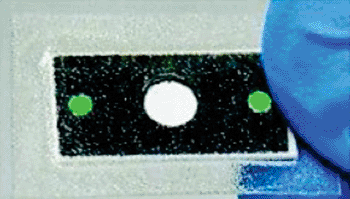Paper-Based Device Brings Medical Testing to Remote Locales
By LabMedica International staff writers
Posted on 06 Nov 2013
An inexpensive point-of-care, paper-based device has been devised to fill the void in remote regions of the world where electricity may not be available and there is a dearth of scientific instruments. Posted on 06 Nov 2013
Tests conducted at a doctor's office or clinical laboratory to detect or monitor disease with a hand-held or desktop electronic device that work by measuring the levels of specific proteins in a patient's blood can indicate a wide range of serious medical conditions.

Image: A paper-based microfluidic device for quantifying active enzyme analytes (Photo courtesy of Pennsylvania State University).
Scientists at the Pennsylvania State University (University Park, PA, USA) developed a new paper-based device to measure enzymes. The device is made from stacked layers of wax-patterned paper that are held together using spray adhesive and then laminated. The dimensions of the paper portion of the device are 20 mm × 10 mm × 1.8 mm; the black regions are hydrophobic wax, and the white regions are hydrophilic paper. Initially they used it to detect alkaline phosphatase, a liver enzyme that in high amounts can suggest liver or bone problems, and β-d-galactosidase an enzyme that is a marker for fecal contamination in water.
After applying a sample to the device, a small white dot turns green if the enzyme is present. After a few seconds or minutes, another small white dot turns green. The longer it takes for the second dot to change color after the first, the higher the concentration of the enzyme. The device uses just a few inexpensive materials and can be altered to measure a wide range of enzymes to monitor many different conditions.
Interference in the reactions depends on the test fluid, so a variety of factors must be considered, most notably whether the fluid contains glucose or hydrogen peroxide that would interfere with the outcome of the assay. To overcome this type of interference, they created a revised device that includes a new layer in which bead-bound glucose oxidase and catalase are deposited into the central channel of the device.
The authors concluded that they have devised a new type of quantitative point-of-care assay platform that offers analytical capabilities that typically are only available using specific instruments. The approach requires a single operation by the user and the assay is completed in seconds to minutes. The readout involves simple measurements of time to quantify the amount of an active enzyme analyte in a sample down to femtomolar levels in simple fluids and low picomolar levels in complex fluids. The assay also is inexpensive, as only paper, food coloring, buffer salts, and microgram quantities of reagents are needed per test. The study was published on September 27, 2013, in the journal Analytical Chemistry.
Related Links:
Pennsylvania State University













